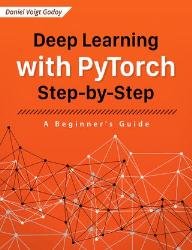Deep Learning with PyTorch : Step-by-Step A Beginner's Guide (2022)
- Добавил: literator
- Дата: 23-10-2022, 13:35
- Комментариев: 0
 Название: Deep Learning with PyTorch : Step-by-Step A Beginner's Guide (2022)
Название: Deep Learning with PyTorch : Step-by-Step A Beginner's Guide (2022)Автор: Daniel Voigt Godoy
Издательство: Leanpub
Год: 2022-02-12 (v1.1.1)
Страниц: 1042
Язык: английский
Формат: pdf (true), epub
Размер: 55.0 MB
If you're looking for a book where you can learn about Deep Learning and PyTorch without having to spend hours deciphering cryptic text and code, and that's easy and enjoyable to read, this is it :-) PyTorch is the fastest-growing framework for developing deep learning models and it has a huge ecosystem. That is, there are many tools and libraries developed on top of PyTorch. It is the preferred framework in academia already and is making its way in the industry. This book aims to get you started with PyTorch while giving you a solid understanding of how it works.
The book covers from the basics of gradient descent all the way up to fine-tuning large NLP models (BERT and GPT-2) using HuggingFace. It is divided into four parts
Part I: Fundamentals (gradient descent, training linear and logistic regressions in PyTorch)
Part II: Computer Vision (deeper models and activation functions, convolutions, transfer learning, initialization schemes)
Part III: Sequences (RNN, GRU, LSTM, seq2seq models, attention, self-attention, transformers)
Part IV: Natural Language Processing (tokenization, embeddings, contextual word embeddings, ELMo, BERT, GPT-2)
This is not a typical book: most tutorials start with some nice and pretty image classification problem to illustrate how to use PyTorch. It may seem cool, but I believe it distracts you from the main goal: how PyTorch works? In this book, I present a structured, incremental, and from first principles approach to learn PyTorch (and get to the pretty image classification problem in due time).
Moreover, this is not a formal book in any way: I am writing this book as if I were having a conversation with you, the reader. I will ask you questions (and give you answers shortly afterward) and I will also make (silly) jokes.
My job here is to make you understand the topic, so I will avoid fancy mathematical notation as much as possible and spell it out in plain English.
In this book, I will guide you through the development of many models in PyTorch, showing you why PyTorch makes it much easier and more intuitive to build models in Python: autograd, dynamic computation graph, model classes and much, much more.
Who Should Read This Book?
I wrote this book for beginners in general—not only PyTorch beginners. Every now and then, I will spend some time explaining some fundamental concepts that I believe are essential to have a proper understanding of what’s going on in the code. The best example is gradient descent, which most people are familiar with at some level. Maybe you know its general idea, perhaps you’ve seen it in Andrew Ng’s Machine Learning course, or maybe you’ve even computed some partial derivatives yourself! In real life, the mechanics of gradient descent will be handled automatically by PyTorch (uh, spoiler alert!). But, I will walk you through it anyway (unless you choose to skip Chapter 0 altogether, of course), because lots of elements in the code, as well as choices of hyper-parameters (learning rate, mini-batch size, etc.), can be much more easily understood if you know where they come from.
Скачать Deep Learning with PyTorch : Step-by-Step A Beginner's Guide (2022)
Внимание
Уважаемый посетитель, Вы зашли на сайт как незарегистрированный пользователь.
Мы рекомендуем Вам зарегистрироваться либо войти на сайт под своим именем.
Уважаемый посетитель, Вы зашли на сайт как незарегистрированный пользователь.
Мы рекомендуем Вам зарегистрироваться либо войти на сайт под своим именем.
Информация
Посетители, находящиеся в группе Гости, не могут оставлять комментарии к данной публикации.
Посетители, находящиеся в группе Гости, не могут оставлять комментарии к данной публикации.
